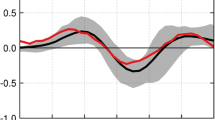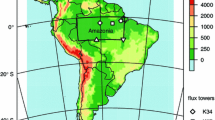Abstract
Purpose of Review
We ask what fundamental insights about the relationship of tropical convection to climate have arisen from recent investigations using simplified models.
Recent Findings
The vertical distribution of relative humidity should remain approximately constant in a changed climate. The temperature of clouds in the upper troposphere should also remain effectively constant for climate changes likely to occur in response to human-induced warming. The fractional coverage of convective clouds will likely decrease slightly with warming, but it is not known how the albedo and net radiative effect of tropical convective clouds will change. The areal extent and net radiative effect of tropical convective clouds depend on the interactions of radiation, cloud physics, and turbulence within the extended upper-level ice clouds. SST gradients develop naturally as a result of the aggregation of convection and large-scale thermodynamics and circulation act to couple the cloud properties and the SST.
Summary
Radiative-convective equilibrium continues to provide insight into the structure and energy balance of the atmosphere by incorporating the interactions among radiation, cloud physics, and atmospheric motion.


Similar content being viewed by others
References
Manabe S, Wetherald RT. Thermal equilibrium of the atmosphere with a given distribution of relative humidity. J Atmos Sci. 1967;24:241–59.
Raval A, Ramanathan V. Observational determination of the greenhouse effect. Nature. 1989;342(6251):758–61.
Soden BJ, Wetherald RT, Stenchikov GL, Robock A. Global cooling after the eruption of Mount Pinatubo: a test of climate feedback by water vapor. Science. 2002;296(APR 26 2002):727–30.
Koll DDB, Cronin TW. Earth’s outgoing longwave radiation linear due to H<sub>2</sub>O greenhouse effect. Proc Nat Acad Sci U S A. 2018;115:10293–8. https://doi.org/10.1073/pnas.1809868115.
Romps DM. An analytical model for tropical relative humidity. J Clim. 2014;27(19):7432–49. https://doi.org/10.1175/jcli-d-14-00255.1.
Pierrehumbert RT. Thermostats, radiator fins and the local runaway greenhouse. J Atmos Sci. 1995;52:1784–806.
Sherwood SC. Maintenance of the free-tropospheric tropical water vapor distribution .2. Simulation by large-scale advection. J Clim. 1996;9(V 1996):2919–34.
Salathe EP, Hartmann DL. A trajectory analysis of tropical upper-tropospheric moisture and convection. J Clim. 1997;10(OCT 1997):2533–47.
Ming Y, Held IM. Modeling water vapor and clouds as passive tracers in an idealized GCM. J Clim. 2018;31(2):775–86. https://doi.org/10.1175/jcli-d-16-0812.1.
Held IM, Soden BJ. Robust responses of the hydrological cycle to global warming. J Clim. 2006;19(21):5686–99.
Pendergrass AG, Hartmann DL. The atmospheric energy constraint on global-mean precipitation change. J Clim. 2014;27(2):757–68. https://doi.org/10.1175/jcli-d-13-00163.1.
Jeevanjee N, Romps DM. Mean precipitation change from a deepening troposphere. Proc Nat Acad Sci U S A. 2018;115(45):11465–70. https://doi.org/10.1073/pnas.1720683115.
Bretherton CS, Blossey PN, Khairoutdinov M. An energy-balance analysis of deep convective self-aggregation above uniform SST. J Atmos Sci. 2005;62(12):4273–92.
Hartmann DL, Larson K. An important constraint on tropical cloud-climate feedback. Geophys Res Lett. 2002;29(20):1951–4. https://doi.org/10.1029/2002GL015835.
Kuang Z, Hartmann DL. Testing the fixed anvil temperature hypothesis in a cloud-resolving model. J Clim. 2007;20:2051–7. https://doi.org/10.1175/JCLI4124.1.
Zelinka MD, Hartmann DL. Why is longwave cloud feedback positive? J Geophys Res Atmos. 2010;115:D16117. https://doi.org/10.1029/2010jd013817.
Hartmann DL. Tropical anvil clouds and climate sensitivity. Proc Natl Acad Sci U S A. 2016;113(32):8897–9. https://doi.org/10.1073/pnas.1610455113.
Hartmann DL, Gasparini B, Berry SE, Blossey PN. The life cycle and net radiative effect of tropical anvil clouds. J Adv Model Earth Sys. 2018;0(0). doi:doi:https://doi.org/10.1029/2018MS001484.
Hartmann DL, Berry SE. The balanced radiative effect of tropical anvil clouds. JGeophys Res-Atmos. 2017;122(9):5003–20. https://doi.org/10.1002/2017jd026460.
Held IM, Hemler RS, Ramaswamy V. Radiative-convective equilibrium with explicit two-dimensional moist convection. J Atmos Sci. 1993;50(23):3909–27.
Tompkins AM, Craig GC. Radiative-convective equilibrium in a three-dimensional cloud-ensemble model. Quart J Roy Meteor Soc. 1998;124(550):2073–97.
Tompkins AM, Craig GC. Time-scales of adjustment to radiative-convective equilibrium in the tropical atmosphere. Quart J Royal Meteorol Soc. 1998;124(552):2693–713.
Tompkins AM, Craig GC. Sensitivity of tropical convection to sea surface temperature in the absence of large-scale flow. J Clim. 1999;12(2):462–76.
Tompkins AM. On the relationship between tropical convection and sea surface temperature. J Clim. 2001;14(5):633–7. https://doi.org/10.1175/1520-0442(2001)014<0633:otrbtc>2.0.co;2.
Su H, Bretherton CS, Chen SS. Self-aggregation and large-scale control of tropical deep convection: a modeling study. J Atmos Sci. 2000;57(JUN 1 2000):1797–816.
Held IM, Zhao M, Wyman B. Dynamic radiative-convective equilibria using GCM column physics. J Atmos Sci. 2007;64(1):228–38.
Tompkins AM. Organization of tropical convection in low vertical wind shears: the role of water vapor. J Atmos Sci. 2001;58(6):529–45. https://doi.org/10.1175/1520-0469(2001)058<0529:ootcil>2.0.co;2.
Wing AA, Emanuel KA. Physical mechanisms controlling self-aggregation of convection in idealized numerical modeling simulations. J Adv Model Earth Sys. 2014;6(1):59–74. https://doi.org/10.1002/2013ms000269.
Muller CJ, Held IM. Detailed investigation of the self-aggregation of convection in cloud-resolving simulations. J Atmos Sci. 2012;69(8):2551–65. https://doi.org/10.1175/jas-d-11-0257.1.
Craig GC, Mack JM. A coarsening model for self-organization of tropical convection. J Geophys Res-Atmos. 2013;118(16):8761–9. https://doi.org/10.1002/jgrd.50674.
Muller C, Bony S. What favors convective aggregation and why? Geophys Res Lett. 2015;42(13):5626–34. https://doi.org/10.1002/2015gl064260.
Jeevanjee N, Romps DM. Convective self-aggregation, cold pools, and domain size. Geophys Res Lett. 2013;40(5):994–8. https://doi.org/10.1002/grl.50204.
Cronin TW, Wing AA. Clouds, circulation, and climate sensitivity in a radiative-convective equilibrium channel model. J Adv Model Earth Sys. 2017;9(8):2883–905. https://doi.org/10.1002/2017ms001111.
Neelin JD, Sahany S, Stechmann SN, Bernstein DN. Global warming precipitation accumulation increases above the current-climate cutoff scale. Proc Nat Acad Sci U S A. 2017;114(6):1258–63. https://doi.org/10.1073/pnas.1615333114.
Muller CJ, O'Gorman PA, Back LE. Intensification of precipitation extremes with warming in a cloud-resolving model. J Clim. 2011;24(11):2784–800. https://doi.org/10.1175/2011jcli3876.1.
Romps DM. Response of tropical precipitation to global warming. J Atmos Sci. 2011;68(1):123–38. https://doi.org/10.1175/2010jas3542.1.
Singh MS, O'Gorman PA. Influence of microphysics on the scaling of precipitation extremes with temperature. Geophys Res Lett. 2014;41(16):6037–44. https://doi.org/10.1002/2014gl061222.
Pfahl S, O'Gorman PA, Fischer EM. Understanding the regional pattern of projected future changes in extreme precipitation. Nature Climate Change. 2017;7(6):423−+. https://doi.org/10.1038/nclimate3287.
Nie J, Sobel AH, Shaevitz DA, Wang SG. Dynamic amplification of extreme precipitation sensitivity. Proc Nat Acad Sci US A. 2018;115(38):9467–72. https://doi.org/10.1073/pnas.1800357115.
Singh MS, O'Gorman PA. Increases in moist-convective updraught velocities with warming in radiative-convective equilibrium. Quart J Roy Meteorol Soc. 2015;141(692):2828–38. https://doi.org/10.1002/qj.2567.
Singh MS, O'Gorman PA. Influence of entrainment on the thermal stratification in simulations of radiative-convective equilibrium. Geophys Res Lett. 2013;40(16):4398–403. https://doi.org/10.1002/grl.50796.
Singh MS, Kuang ZM, Maloney ED, Hannah WM, Wolding BO. Increasing potential for intense tropical and subtropical thunderstorms under global warming. Proc Natl Acad Sci U S A. 2017;114(44):11657–62. https://doi.org/10.1073/pnas.1707603114.
Seeley JT, Romps DM. Why does tropical convective available potential energy (CAPE) increase with warming? Geophys Res Lett. 2015;42(23). https://doi.org/10.1002/2015gl066199.
Bretherton CS, Park S. A new bulk shallow-cumulus model and implications for penetrative entrainment feedback on updraft buoyancy. J Atmos Sci. 2008;65(7):2174–93. https://doi.org/10.1175/2007jas2242.1.
Bretherton CS. Insights into low-latitude cloud feedbacks from high-resolution models. Phil Trans Roy Soc A. 2015;373(2054). https://doi.org/10.1098/rsta.2014.0415.
Stevens B, Bony S, Webb M. Clouds on-off klimate intercomparison experiment (COOKIE). Tech. rep.2013.
Harrop BE, Hartmann DL. The role of cloud radiative heating in determining the location of the ITCZ in Aquaplanet simulations. J Clim. 2016;29(8):2741–63. https://doi.org/10.1175/jcli-d-15-0521.1.
Watt-Meyer O, Frierson DMW. Local and remote impacts of atmospheric cloud radiative effects onto the eddy-driven jet. Geophys Res Lett. 2017;44(19):10,036–10,44. https://doi.org/10.1002/2017GL074901.
Voigt A, Shaw TA. Impact of regional atmospheric cloud radiative changes on shifts of the extratropical jet stream in response to global warming. J Clim. 2016;29(23):8399–421. https://doi.org/10.1175/jcli-d-16-0140.1.
Ceppi P, Hartmann DL. Clouds and the atmospheric circulation response to warming. JClimate. 2016;29(2):783–99. https://doi.org/10.1175/jcli-d-15-0394.1.
Dobbie S, Jonas P. Radiative influences on the structure and lifetime of cirrus clouds. Quart J Roy Meteorol Soc. 2001;127(578):2663–82. https://doi.org/10.1256/smsqj.57807.
Wall CJ, Hartmann DL. Balanced cloud radiative effects across a range of dynamical conditions over the tropical West Pacific. Geophys Res Lett. 2018;45(20):11490–8. https://doi.org/10.1029/2018gl080046.
Folkins I, Loewenstein M, Podolske J, Oltmans SJ, Proffitt M. A barrier to vertical mixing at 14 km in the tropics: evidence from ozonesondes and aircraft measurements. J Geophys Res Atmos. 1999;104(SEP 27 1999):22095–102.
Hartmann DL, Holton JR, Fu Q. The heat balance of the tropical tropopause, cirrus, and stratospheric dehydration. Geophys Res Lett. 2001;28(10):1969–72.
Folkins I. Origin of lapse rate changes in the upper tropical troposphere. J Atmos Sci. 2002;59(5):992–1005.
Harrop BE, Hartmann DL. Testing the role of radiation in determining tropical cloud-top temperature. JClimate. 2012;25(17):5731–47. https://doi.org/10.1175/jcli-d-11-00445.1.
Thompson DWJ, Bony S, Li Y. Thermodynamic constraint on the depth of the global tropospheric circulation. Proc Nat Acad Sci U S A. 2017;114(31):8181–6. https://doi.org/10.1073/pnas.1620493114.
Thompson DWJ, Ceppi P, Yi Y. Testing a key constraint on extratropical tropopause height J Climate. 2018:submitted.
Seeley JT, Jeevanjee N, Langhans W, Romps DM. Formation of tropical anvil clouds by slow evaporation. Geophys Res Lett 0(0). https://doi.org/10.1029/2018GL080747.
Seeley JT, Jeevanjee N, Romps DM. FAT or FiTT: are anvil clouds or the tropopause temperature-invariant? Geophys Res Lett.0(ja). https://doi.org/10.1029/2018GL080096.
Romps DM, Kuang ZM. Do undiluted convective plumes exist in the upper tropical troposphere? J Atmos Sci. 2010;67(2):468–84. https://doi.org/10.1175/2009jas3184.1.
Hartmann DL. Global Physical Climatology. 2nd ed. Elsevier; 2016.
de Rooy WC, Bechtold P, Frohlich K, Hohenegger C, Jonker H, Mironov D, et al. Entrainment and detrainment in cumulus convection: an overview. Q J R Meteorol Soc. 2013;139(670):1–19. https://doi.org/10.1002/qj.1959.
Khairoutdinov MF, Randall DA. Cloud resolving modeling of the ARM summer 1997 IOP: model formulation, results, uncertainties, and sensitivities. J Atmos Sci. 2003;60(4):607–25.
Clough SA, Shephard MW, Mlawer E, Delamere JS, Iacono M, Cady-Pereira K, et al. Atmospheric radiative transfer modeling: a summary of the AER codes. J Quanti Spectros Rad Trans. 2005;91(2):233–44. https://doi.org/10.1016/j.jqsrt.2004.05.058.
Morrison H, Milbrandt JA. Parameterization of cloud microphysics based on the prediction of bulk ice particle properties. Part I: scheme description and idealized tests. J Atmos Sci. 2015;72(1):287–311. https://doi.org/10.1175/jas-d-14-0065.1.
Glenn IB, Krueger SK. Downdrafts in the near cloud environment of deep convective updrafts. J Adv Model Earth Sys. 2014;6(1):1–8. https://doi.org/10.1002/2013ms000261.
Katzwinkel J, Siebert H, Heus T, Shaw RA. Measurements of turbulent mixing and subsiding shells in trade wind cumuli. J Atmos Sci. 2014;71(8):2810–22. https://doi.org/10.1175/jas-d-13-0222.1.
Kuang ZM, Bretherton CS. Convective influence on the heat balance of the tropical tropopause layer: a cloud-resolving model study. J Atmos Sci. 2004;61(23):2919–27.
Popke D, Stevens B, Voigt A. Climate and climate change in a radiative-convective equilibrium version of ECHAM6. J Adv Model Earth Sys. 2013;5(1):1–14. https://doi.org/10.1029/2012ms000191.
Reed KA, Medeiros B, Bacmeister JT, Lauritzen PH. Global radiative-convective equilibrium in the community atmosphere model, version 5. J Atmos Sci. 2015;72(5):2183–97. https://doi.org/10.1175/jas-d-14-0268.1.
Coppin D, Bony S. Internal variability in a coupled general circulation model in radiative-convective equilibrium. Geophys Res Lett. 2017;44(10):5142–9. https://doi.org/10.1002/2017gl073658.
Hohenegger C, Stevens B. Coupled radiative convective equilibrium simulations with explicit and parameterized convection. J Adv Model Earth Sys. 2016;8(3):1468–82. https://doi.org/10.1002/2016ms000666.
Arnold NP, Putman WM. Nonrotating convective self-aggregation in a limited area AGCM. J Adv Model Earth Sys. 2018;10(4):1029–46. https://doi.org/10.1002/2017ms001218.
Bony S, Stevens B, Coppin D, Becker T, Reed K, Voigt A, et al. Thermodynamic control of anvil-cloud amount. Proc Nat Acad Sci U S A. 2016;113(32):8927–32. https://doi.org/10.1073/pnas.1601472113.
Kiehl JT. On the observed near cancellation between longwave and shortwave cloud forcing in tropical regions. J Clim. 1994;7(4):559–65.
Hartmann DL, Moy LA, Fu Q. Tropical convection and the energy balance at the top of the atmosphere. J Clim. 2001;14(24):4495–511. https://doi.org/10.1175/1520-0442(2001)014<4495:TCATEB>2.0.CO;2.
Wall CJ, Hartmann DL, Thieman MM, Smith WL, Minnis P. The life cycle of anvil clouds and the top-of-atmosphere radiation balance over the tropical West Pacific. J Clim. 2018;31(24):10059–80. https://doi.org/10.1175/jcli-d-18-0154.1.
Becker T, Stevens B, Hohenegger C. Imprint of the convective parameterization and sea-surface temperature on large-scale convective self-aggregation. J Adv Model Earth Sys. 2017;9(2):1488–505. https://doi.org/10.1002/2016ms000865.
Coppin D, Bony S. On the interplay between convective aggregation, surface temperature gradients, and climate sensitivity. J Adv Model Earth Sys. 2018;10(12):3123–38. https://doi.org/10.1029/2018MS001406.
Acknowledgments
The authors thank Tim Cronin and an anonymous reviewer for very helpful comments and suggestions.
Funding
Support was from the National Science Foundation under Grant AGS-1549579 and from the Regional and Global Climate Modeling Program of the Office of Science of the U.S. Department of Energy (DE-SC0012580).
Author information
Authors and Affiliations
Corresponding author
Ethics declarations
Conflict of Interest
The authors state that there are no conflicts of interest.
Additional information
Publisher’s Note
Springer Nature remains neutral with regard to jurisdictional claims in published maps and institutional affiliations.
This article is part of the Topical Collection on Convection and Climate
Rights and permissions
About this article
Cite this article
Hartmann, D.L., Blossey, P.N. & Dygert, B.D. Convection and Climate: What Have We Learned from Simple Models and Simplified Settings?. Curr Clim Change Rep 5, 196–206 (2019). https://doi.org/10.1007/s40641-019-00136-9
Published:
Issue Date:
DOI: https://doi.org/10.1007/s40641-019-00136-9




